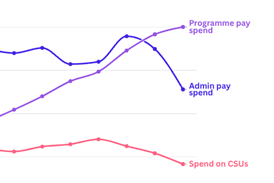Staffing is the issue keeping NHS leaders awake at night – and which consumes two-thirds of trusts’ spending. The fortnightly The Ward Round newsletter, by HSJ workforce correspondent Annabelle Collins, ensures you are tuned in to the daily pressures on staff, and the wider trends and policies shaping the workforce.
Martha Mills should have survived falling off her bike during a family holiday in Wales last year. The handlebar injury she sustained was wholly treatable. But a litany of catastrophic errors made by the doctors at King’s College Hospital Foundation Trust while caring for her meant she did not.
Martha’s mother Merope Mills has written a detailed and harrowing account of what happened to Martha while being treated at King’s last summer. Over the month spent in hospital, Martha deteriorated. However, her medical team did not share with her parents the full extent of how unwell she was, with the signs of sepsis not recognised and too little action taken far too late.
Her hepatologist consultants also resisted involving the paediatric intensive care department, which was in the same building. When her family raised concerns, they were told to “trust the doctors”.
The coroner’s Prevention of Future Deaths report, published in March, specifically raised concerns about the relationship between the paediatric hepatologists and the paediatric intensivists; “If she had been referred promptly and had been appropriately treated, the likelihood is she would have survived her injuries”, was the coroner’s damning conclusion.
Ms Mills also described the liver team as “reluctant to do the right thing and involve intensive care: Martha died in part because of inflated egos”.
This desperately sad story raises numerous serious issues, relating not only to medical error, but also to the dangers of siloed working, an ingrained toxic culture of deference, and a failure to listen to and respond to concerns raised by patients and their families.
‘As serious as a major infection’
It is also not unique. Cases of poor culture leading to patient harm have also been seen at Great Ormond Street, Morecambe Bay and St George’s, to name a few examples that spring to mind.
What happened to Martha could happen at any trust. Senior leaders I’ve spoken to describe how this is something they fear.
I’ve been told of the measures chief executives have put in place to try and reduce the likelihood of harm happening in healthcare. These include: working to grow a culture that supports speaking up; complete openness with patients and families; learning from mistakes; surrounding yourself with the best people; and getting the right governance in place.
However, non-clinical leaders described a struggle to understand whether appropriate clinical care was given. One told me of a test they use: ‘How would I feel if this happened to a member of my family?’
Michael West, a senior visiting fellow at The King’s Fund and professor of work and organisational psychology at Lancaster University, has worked with many trusts to improve culture, care quality, and staff experience.
His research has shown the NHS often manages through extended hierarchies, with team-working problems often beginning with the executive team, who have created “siloed working”.
“You need frequent contact to work through this conflict and everyone is responsible for this. Every team should be asking ‘how can we help you’,” Mr West says. “A breakdown in relationships is as serious as a major infection, but we don’t treat it the same way.”
He gives examples of two different sorts of leaders – those who problem seek and those who comfort seek, the former “actively seeking out weaknesses in a organisation, talking regularly to staff and patients”, whereas the latter are more “self-congratulatory”.
Dangerous hierarchies
Mr West also stresses hierarchy is inimical to safe teamworking, describing a “dangerous” fear among junior doctors to escalate concerns above their consultant.
He says: “Everybody in a team is responsible for creating a good climate and taking responsibility for talking about toxic politics and poor relationships. Compassion is having the courage to raise these concerns.”
When talking to medics about this case, they have described a “conflict” between being taught at medical school to challenge and speak up with concerns, but only to escalate within your immediate team. Challenging your superiors is difficult and “not the done thing”. This must change, but dismantling and interrogating such an ingrained culture will take time.
Workforce shortages and a lack of resources were not factors in Martha’s death. It was within the hospital’s means to provide better care and the trust has acknowledged there were things “it could and should have done differently”.
A King’s spokesman has said the trust made a “number of improvements over the past year as a result of learnings from Martha’s case”.
In a statement addressing the poor relationships between departments, he said: “We have invested in a dedicated paediatric critical care outreach service at our King’s College Hospital site to ensure children who deteriorate are identified. We have also introduced a daily safety huddle between staff on Rays of Sunshine ward and the paediatric critical care unit at King’s. We are also developing a mandatory training module on sepsis for all clinical staff in paediatrics.”
Its chief executive Clive Kay added: “I am deeply sorry that we failed Martha when she needed us most. Our focus now is on ensuring the specific learnings from her case are used to improve the care our teams provide – and that is what we are committed to doing.”
This is, of course, not just an opportunity for King’s to consider the learnings from this case, but for the NHS as a whole. The same dangerous culture will take root anywhere if given the chance and leaders must make it their business to stop it if future harm is to be prevented.



























No comments yet